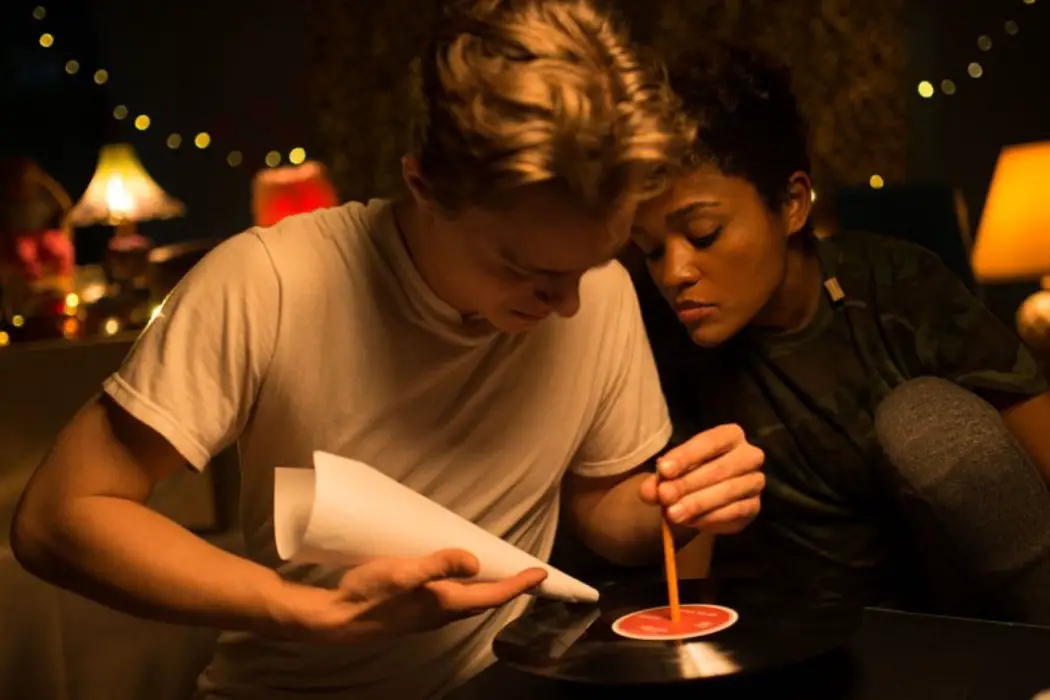GIVE ME LIBERTY: A Beautifully Chaotic Slice Of Life

Janet is a writer based in Salt Lake City. A…
Director Kirill Mikhanovsky’s bold and poignant Give Me Liberty brings a charming slice of life portrait that humbly invites us into the Milwaukee community. Led by a diverse cast, comprised largely of non-actors, the film takes us on a wild ride (literally) through the communities and pockets of the city.
Featuring stylized editing, choreography, and cinematography, the film is unfailingly bold when it comes to applying experimental techniques to such an organic narrative. It showers the film with originality and authenticity that does justice to a community brought to life by a team of filmmakers who hold a deep connection to the city.
Graceful Chaos
The film paints a day-in-the-life portrait of a young man, Vic (Chris Galust), a second-generation Russian kid who works as a medical transport driver in Milwaukee. He gets his grandfather up and ready in the early hours of the morning and drives from town to town, picking up people of disabilities and taking them to where they need to be.
It’s not until he’s pressured into taking his relatives and ailing grandfather to a funeral where things start to quickly reel out of control. Strong-willed, Tracy, a young woman with ALS (Lauren “Lolo” Spencer), along with a few other clients, is pulled into the commotion. As schedules fall out of line and unexpected circumstances bloom, the van and the story quickly turns into a madhouse framed in a slapstick formula.

As we’re pulled into this fast-paced commotion, we’re taken to a talent show, a funeral, an apartment fire, and political protest – all in one day. One thing leads to the next and it becomes a raucous, emotional, and joyful ride full of endearing characters. Despite the chaos, the film makes sure to stop and smell the roses.
The film is imbued with farce, but that doesn’t mean it carries a silly narrative with bumbling buffoons. The filmmaker portrays real people with real issues and responsibilities that gets in the way of their day-to-day life. Vic is a man who carries a lot of responsibilities; a lot of people rely on him, and Mikhanovsky along with his co-writer and producer, Alice Austen, is sure to illustrate the pressure, anxiety, and stress that comes with this.
There’s no fluff and no cheese to the story. It certainly doesn’t need any, as the film is very touch and go. More importantly, the film pulls real and personal tales from its actors and scenes from the surrounding Milwaukee community that crafts a very absorbing experience. Majority of his actors are Russian immigrants and people with a variety of disabilities from the Eisenhower Center, a nonprofit that vocational training program for people with disabilities.
A Community Reflected Organically Onscreen
Milwaukee is the most segregated city in the States, and the film illustrates this as the van veers through various neighborhoods, families, and individuals. It’s not a political film, but rather, it’s used as a backdrop to highlight the life and tension that the people face.
Give Me Liberty is part documentary, part fiction, part comedy, and part drama. This blending of genres are sewn beautifully together that illuminate the humanity behind the community of Milwaukee.

As characters talk, there are moments when the film cuts away to various scenes of the city or different shots of characters (probably the loveliest of them all are shots of the Eisenhower Center). It gives it a biographical feel that not only becomes an ode to Milwaukee, but an ode life’s uncontrollable forces. It’s what shapes us and makes us human.
Bold Use of Color and Style
Mikhanovsky’s greatest asset is his use of editing and choreography. He has a knack for making us feel that were being tangled in ball of anxiety. The way the film cuts back and forth from scene to scene and person to person, is an art form in itself. It’s wildly entertaining to watch.
He also uses black and white at one point in the film which is a really bold choice. It’s a choice that is admirable. Although it seems to come at a surprise in the beginning, this black and white experience helps us to stay with the characters. It helps us zero in on the subjects amid all the commotion of a protest.

There’s a brief scene of Vic at a party. It’s dark and there are neon lights shimmering against his face; he’s sort of zoned out and in his own head. It’s these small moments where Mikhanovsky takes time to breath and soak in oblivion. They might seem trivial but turn out to be deeply personal moments. Moments like these shows how much the filmmaker is in tune with the emotional sensibilities of his characters and the human condition.
Conclusion: Give Me Liberty
We may not ride in a van with over ten people on a daily basis, but it’s surely a kind of chaos and stress that we can relate with. Sometimes, they’re in the form of a messy and contradicting internal dialogue that dances in our minds. However manifested, it’s an experience that filmmaker Mikhanovsky cunningly and meditatively brings to life onscreen.
There’s plenty of reflection on life, choices, and loss that are weaved through the chaos thanks to the cast from all walks of life. This story was inspired by Mikhanovsky’s own life in which he drove a medical transport van around Milwaukee as a young Russian immigrant.
Give Me Liberty certainly evokes a sense of timelessness and universality that permeates through every element of the film. It’s a ride that opens the door to a diverse and important community. With wonderfully raw and absorbing performances, this small tale is a rare treat.
What are some of your favorite slice-of-life films? Please share by commenting below!
Give Me Liberty was released in theaters in the U.S. on August 23, 2019. For international release dates, see here.
Does content like this matter to you?
Become a Member and support film journalism. Unlock access to all of Film Inquiry`s great articles. Join a community of like-minded readers who are passionate about cinema - get access to our private members Network, give back to independent filmmakers, and more.
Janet is a writer based in Salt Lake City. A strong advocate for underrepresented voices, she believes cinema is a transformative medium that challenges assumptions and creates diverse conversations.













